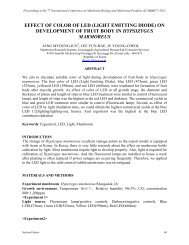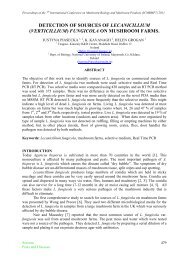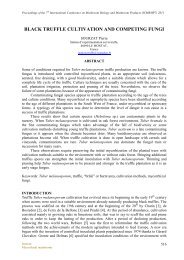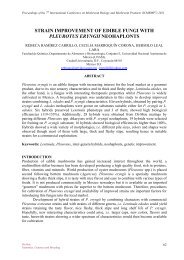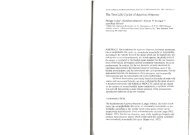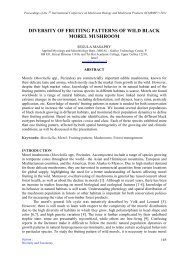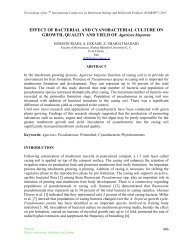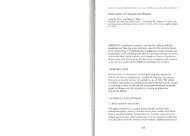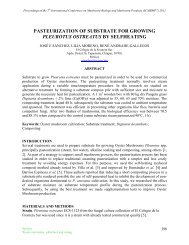Molecular identification of mating type genes in asexual spores of ...
Molecular identification of mating type genes in asexual spores of ...
Molecular identification of mating type genes in asexual spores of ...
Create successful ePaper yourself
Turn your PDF publications into a flip-book with our unique Google optimized e-Paper software.
Proceed<strong>in</strong>gs <strong>of</strong> the 7 th International Conference on Mushroom Biology and Mushroom Products (ICMBMP7) 2011<br />
There are two different sources <strong>mat<strong>in</strong>g</strong> <strong>type</strong> locus <strong>of</strong> Cordyceps militaris. One is <strong>mat<strong>in</strong>g</strong><br />
<strong>type</strong> loci MAT-alpha, conta<strong>in</strong>s two k<strong>in</strong>ds <strong>of</strong> <strong>mat<strong>in</strong>g</strong> <strong>type</strong> gene sequence, named MAT1-1-1 and<br />
MAT1-1-2, while the other <strong>mat<strong>in</strong>g</strong> <strong>type</strong> loci MAT-HMG conta<strong>in</strong>s only one <strong>mat<strong>in</strong>g</strong> <strong>type</strong> gene<br />
sequence, named MAT1-2-1 [3]. In the process <strong>of</strong> sexual reproduction <strong>in</strong> C. militaris,<br />
homocaryotic mycelium carry<strong>in</strong>g dist<strong>in</strong>ct <strong>mat<strong>in</strong>g</strong> <strong>type</strong> <strong>genes</strong> are compatible with each other. After<br />
plasmogamy, these compatible homocaryotic mycelia form pairs, heterocaryotic mycelium,<br />
<strong>in</strong>itiat<strong>in</strong>g the dikaryophase <strong>of</strong> the sexual cycle. Then after karyogamy and meiosis and the<br />
formation <strong>of</strong> asco<strong>spores</strong>, heterocaryons complete sexual life cycle. Accord<strong>in</strong>g to the life cycle <strong>of</strong><br />
Cordyceps militaris, homocaryotic mycelia have one <strong>type</strong> <strong>of</strong> <strong>mat<strong>in</strong>g</strong> <strong>type</strong> <strong>genes</strong>, while<br />
heterocaryotic mycelia have two <strong>type</strong>s <strong>of</strong> <strong>mat<strong>in</strong>g</strong> <strong>type</strong> <strong>genes</strong>. So we can identify the nuclear phase,<br />
homocaryon or heterocaryon, by <strong>in</strong>dentify<strong>in</strong>g the <strong>type</strong> <strong>of</strong> <strong>mat<strong>in</strong>g</strong> <strong>type</strong> <strong>genes</strong> <strong>of</strong> Cordyceps<br />
militaris.<br />
This study isolated 200 stra<strong>in</strong>s germ<strong>in</strong>ated from <strong>asexual</strong> <strong>spores</strong> <strong>of</strong> two Cordyceps<br />
militaris stra<strong>in</strong>s. We <strong>in</strong>dentified <strong>mat<strong>in</strong>g</strong> <strong>type</strong> <strong>genes</strong> <strong>of</strong> these 200 isolates by PCR.<br />
MATERIALS AND METHODS<br />
Stra<strong>in</strong>s. Cordyceps militaris stra<strong>in</strong>s, CM-23B and CM-H07, were obta<strong>in</strong>ed from Institute <strong>of</strong><br />
Edible Fungi, Shanghai Academy <strong>of</strong> Agricultural Sciences (SAAS). Cordyceps militaris mycelia<br />
cultured on potato dextrose agar medium (PDA).<br />
Preparation <strong>of</strong> <strong>asexual</strong> spore suspension and s<strong>in</strong>gle spore isolates. Stra<strong>in</strong>s were <strong>in</strong>oculated on<br />
PDA plates, 25 ℃ for 10 days dark culture. Then PDA plates covered with mycelium were<br />
washed by 1mL <strong>of</strong> sterile water to collect mycelium. Asexual <strong>spores</strong> were isolated by G-2 glass<br />
filter and suspended by sterile water and diluted to 10 5 ml -1 . 100μl spore suspension was poured<br />
onto a PDA plant. The plate was <strong>in</strong>cubated at 25 ℃ <strong>in</strong> a dark place. When visible colonies<br />
appeared, these colonies were subcultured <strong>in</strong>dividually onto fresh PDA plates, and <strong>in</strong>cubated at 25<br />
℃ <strong>in</strong> a dark place until they were covered with mycelium completely. Then these mycelium were<br />
scraped down and freeze-dried until use.<br />
Genomic DNA extraction method <strong>of</strong> Cordyceps militaris. The genomic DNA was extracted<br />
from Cordyceps militaris with the improved CTAB method [4]. Methods briefly described as<br />
follows: freeze-dried Cordyceps militaris hyphae ground to powder was added to 65℃ preheated<br />
2 x CTAB extraction liquid (2% CTAB; 1.4 M NaCl; 100mM Tris-HCl; 20mM EDTA, pH8.0),<br />
and was <strong>in</strong>cubated at 65°C at least 30 m<strong>in</strong>, then centrifuged at room temperature, 12000 rpm for<br />
10 m<strong>in</strong>. The supernatant was transferred <strong>in</strong>to another fresh 1.5 ml tube,then equivalent volume<br />
<strong>of</strong> phenol-chlor<strong>of</strong>orm(1:1) was added, mixed gently but thoroughly about 1 m<strong>in</strong>. This mixture<br />
centrifuged (12000 rpm) for 10m<strong>in</strong>. The supernatant was transferred <strong>in</strong>to another fresh 1.5 ml tube<br />
and equivalent volume <strong>of</strong> chlor<strong>of</strong>orm-isoamyl alcohol (24:1) was added, well mixed, then<br />
centrifuged (12000 rpm) for 10m<strong>in</strong>. The supernatant was transferred <strong>in</strong>to another fresh tube, and<br />
1/10 volume 3M NaAc was added, then 2/3 volume -20°C precooled isopropanol was added, and<br />
then <strong>in</strong>cubated at -20°C for 20 m<strong>in</strong>utes, centrifuged at 4℃, 12 000 rpm for 10 m<strong>in</strong>. The<br />
precipitation was washed with 75%ethanol for twice, air dried and resuspended <strong>in</strong> 30μl TE buffer.<br />
1μl RNase(10mg/ml) was added to the DNA solution for 1 hour at 37°C to remove RNA. The<br />
f<strong>in</strong>al DNA extracts were stored at -20°C until use.<br />
Specific primers amplification for identify<strong>in</strong>g <strong>mat<strong>in</strong>g</strong> <strong>type</strong> <strong>genes</strong> <strong>of</strong> Cordyceps militaris. Three<br />
specific primer pairs, shown <strong>in</strong> Table 1, designed accord<strong>in</strong>g to the reference <strong>mat<strong>in</strong>g</strong> <strong>type</strong> <strong>genes</strong> <strong>of</strong><br />
C. militaris deposited <strong>in</strong> the NCBI database(registration number AB084257 and AB194982), were<br />
used for PCR amplification <strong>of</strong> the <strong>mat<strong>in</strong>g</strong> <strong>type</strong> <strong>genes</strong> MAT1-1-2, MAT1-1-1 and MAT 1-2-1.<br />
Section:<br />
Genomics, Genetics and Breed<strong>in</strong>g<br />
53



